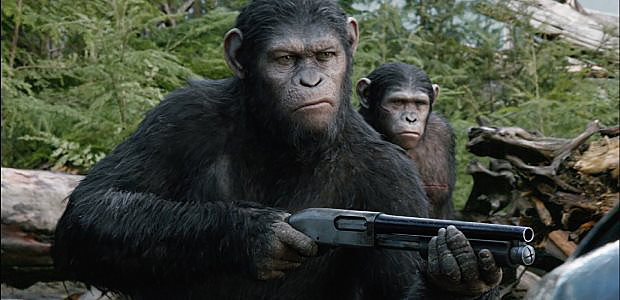Never has a sequel achieved such distinction in storytelling by seamlessly blending science fiction with reality. More than just an epic blockbuster packed with equal parts heart, soul and insight – Dawn of the Planet of the Apes is as much a technical marvel as it is a quintessential milestone in filmmaking. For lack of better words, in its entirety, this film is the dawn of the evolution of cinema as we know it.
One of the closing questions I asked in my review of Rise of the Planet of the Apes (one of 2011’s curve ball hit films) was – Will we as humans eventually cause our own extinction and in the process allow another species to reign supreme? Not only is that question answered with such precision, returning script writers Rick Jaffa and Amanda Silver spins such a yarn, this time around, that cinema’s core ethos of ‘make believe’ is taken to unprecedented new heights of storytelling. In crafting this illusion of reality, Cloverfield director Matt Reeves gives us a glimpse of a bleak future that is in every way a stark contrast to James Cameron’s fantasy world in Avatar. Set ten years after the events of the preceding film, a simian flu called the ALZ-113 virus has all but wiped out mankind. When a band of survivors led by Malcolm (Jason Clarke) and Ellie (Keri Russell) seek to restore power to a decimated San Francisco, they encounter a new generation of apes led by the super intelligent chimp Caesar (Andy Serkis at his brilliant best). As a proud and noble alpha male, Caesar is compassionate to humans as well as his tribe of apes thriving in the woods surrounding San Francisco. But in allowing humans access to a hydro-electric dam, both sides have at least one major obstacle to overcome. Koba (Toby Kebbell), Caesar’s deputy bears the scars of human cruelty as a lab test subject. On the other side, Dreyfus (Gary Oldman) a trigger happy military man blames the apes for the outbreak of the virus that killed his family. At this point, it’s needless to say that peace between humans and apes bear a striking similarity to the current state of socio-political diplomacy in the real world. Similarly, for Malcolm and Caesar, the fragility of peace is tested on the strength of trust and forgiveness, each with depleted levels on both sides.
After much inter-species finger pointing in the first hour, Reeves lets loose flaming arrows by way of a spectacular battle sequence, but not before tightening each passing minute with cork-screw tension. Each passing minute also leads to metaphors that serve to illustrate our bloody history of wars, mutinies, and conflicted leadership. Just like the preceding film, Dawn raises a few questions that strikes fear into the heart of the viewer because the film’s most unnerving question is not about who we are but about what we have become. This is Kebbell’s moment as a perfectly camouflaged Shakespearean Brutus. Kebbell’s portrayal of a war craving despot is second only to the highly watchable Caesar in what has to be Serkis’ most charismatic performance to date. Although the accolade of blurring the lines between virtual reality and live action cinema firmly rests with New Zealand based studio Weta Digital, thinking that an ape has been trained to act while also knowing that it is a product of CG animation is the greatest achievement in this film. That being said, human characterization seems to have taken a back seat in the process as more than 75 percent of the production favors the apes with every minute detail dedicated towards their emotions, aesthetics, communication and path to civilization. As such, Oldman and Russell have little to work with, relying on Clarke to shoulder human elements of the story.
Dawn of the Planet of the Apes can be easily misread as an analogy on the current state of real world events and the mounting tension that is bringing nations to the brink of war. But under the guidance of Reeves, this film is primarily a stunning visual experience with all the sophistication yet none of the camp silliness found in other big budget productions. Apart from the photo-realistic aplomb of motion-performance technology, James Chinlund’s production design is perfectly integrated with Michael Seresin’s cinematography of a post-apocalyptic world in a way that doesn’t require a 3D viewing. Together with Michael Giacchino’s goose-bump raising original score, something tells me these technical achievements will not go unnoticed. For now, Caesar lives. And through this film, be prepared to be conquered all over again!
Rating: 




